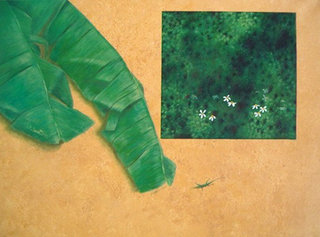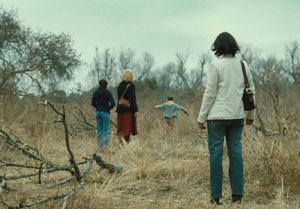November 2009
Monthly Archive
Sun 29 Nov 2009
Posted by Rachel Deluca under
Uncategorized[2] Comments
For my event, I went to Edgewood College in Madison and saw an art show. The name of the art show was “Celebrating Friendship”. There were two artists that were being displayed. They were Orestes Larios Zaak and Gregorio Perez Escobar.
Orestes was born on April 15 in 1953. He studied at the National School of Art in Havana, Cuba. He graduated from Instituo Superior Pedagogico, with a Masters Degree of Art. He is known for his use of nature. He tries to emphasize the honesty, kindness and integrity that nature offers to humanity. His work gives of a great sense of peace and calmness. On of my favorite works of art by Orestes was a painting called “Crepusculo” (Twilight). It was a blending of deep greens with small, white flowers and a few bees hovering them (Unfortunately I could not find a picture of it online). The pictures at the show were all related with each other in many ways. The main comparison was the focus of nature. Some other similarities were grass, flowers (mainly white ones), bees, lizards and sand.

Orestes Larios Zaak

Orestes Larios Zaak
Gregorio’s work focused on universal paradoxes. He, as well as Orestes, liked to tie nature into his work. That is one of his reasons for using wood. He says that it helps the spectator to relate his work to nature almost immediately. He also says that his ultimate goal is that humanity realizes their problems and fixes them. I have a few favorite pieces of art. They are, “Communication” which is a children’s slide, but the slide is a person’s tongue and the ladder of the slide is broken and missing rungs, and “Gone” which is a pistol. I couldn’t find any personal information on Gregorio.

Gregorio Perez Escobar

Communication
Overall, I really enjoyed the art show. These two men are very talented. This relates to our class very well. We just got through the unit of art and learned how important it was to the Latin culture. Political topics are well like in the Latin art. Some say it is not art unless it shows a political view, but some don’t agree. These two artists didn’t show a political view at all. Instead they focused on nature and tried to bring in actions that humankind is doing to the world that aren’t necessarily right. They try to think critically and bring that into their art.
Sources Used:
http://translate.google.com/translate?hl=en&sl=es&u=http://www.radiosantacruz.icrt.cu/seccion/personalidades_cubanas/orestes-larios-zaak-larios-datos-biograficos.htm&ei=nqkSS8XqE4u0lAfG_PWOBA&sa=X&oi=translate&ct=result&resnum=9&ved=0CCkQ7gEwCA&prev=/search%3Fq%3Dorestes%2Blarios%2Bzaak%26hl%3Den%26client%3Dsafari%26rls%3Den
http://images.google.com/imgres?imgurl=http://pics.livejournal.com/cubarte/pic/00019pf7/s320x240&imgrefurl=http://cubarte.livejournal.com/&usg=__pQFPjmU66kIcnfOOdFPhTiSGVyA=&h=237&w=320&sz=42&hl=en&start=7&um=1&tbnid=6KuDQvoVwM9QMM:&tbnh=87&tbnw=118&prev=/images%3Fq%3Dorestes%2Blarios%2Bzaak%26hl%3Den%26client%3Dsafari%26rls%3Den%26um%3D1
Wed 25 Nov 2009
Posted by Michelle Alvarado under
UncategorizedNo Comments

The Holiday Folk Fair International is an event for all ages! The event always has a theme and this year the theme is to celebrate the weavings of culture. Cultures all over the world are brought together in this wonderful event for us to explore the customs and traditions of the world’s diverse culture. Food stands are set up so that you can walk around to see and hopefully try samples of traditional dishes from various countries. As you sit to eat you can watch events of the Ballet Folklo’rico Huehuecoyotl dancers or even the Filipino youth dance. They even have a music pavilion for you to relax and watch. I was able to listen to Trío Los Jinetes a Mexican mariachi and romantic band that play for weddings, Quince Años and baptisms. You can even walk around to see what kind of handicraft artifacts may be found world-wide. They even offer various craft demonstrations where you can see wood carving demonstrations, lace making and much more. The one thing that you should not forget to do is stop by heritage lane and get your “passport” stamped as you walk through the different walks of life and learn a little about each.
This event has been a family tradition for me. We used to go every year as I grew up until about 6 years ago and have decided to begin going again to enrich our children with the cultural diversities that we were given. It always amazes me to see many people of different backgrounds coming together and learn about one another. I questioned whether or not my niece would try the variety of food since the only food that she will eat is chicken nuggets or macaroni and cheese. This is not even an exaggeration. For the first time I was able to see her enjoy other food. We ate chicken fried rice form the Chinese booth, Honey puffs and Gyros from the Greek booth and if we hadn’t had enough from our own heritage we sampled Churros and tamales from the Mexican booth.
However for the class I began to wonder about what other Latin American foods they had to sample and needless to say I found a Filipino booth where they served adobo with rice, Pansit, Mami, Siopao, Leche flan, Cassava, Turon and Nagaraya Nuts and Salabat. I tried the Adobo with rice and it was very tasteful. I began to question what Adobo meant so I went on line to find this Filipino cuisine and learned that Adobo refers to a common and very popular cooking process indigenous to the Philippeans. It involves stewing with vinegar, which they then referred to as “adobo”. This word is actually Spanish and it means seasoning or marinade. Usually a pork or chicken, maybe even both, is slowly cooked in soy sauce, crushed garlic, vinegar, bay leaf and black peppercorns. It is then pan fried or cooked in an oven to get the crisped edges. If this sounds delicious to you come and check it out next near for the 2010 Holiday Folk Fair International. You could even be like me and walk out with a Mexican flute that only costs $1.
Mon 16 Nov 2009
Posted by Bert Kreitlow under
UncategorizedNo Comments
David Samuels, a University of Minnesota professor of Political Science will speak on “The Evolution of the Workers’ Party: Implications for Understanding Brazilian Politics and Society” on Tuesday, Dec. 1 at noon at UW-Madison.
The talk is part of a series of lunchtime lectures sponsored by the campus Latin American and Caribbean and Iberian Studies Program. The event, which includes a light lunch, will take place in room 206 of Ingraham Hall.
Mon 16 Nov 2009
Posted by Bert Kreitlow under
UncategorizedNo Comments

Haitian writer Edwidge Danticat
Edwidge Danticat will deliver a lecture on Nov. 23 at the Wisconsin Room of the UW-Milwaukee student union at 7 p.m.
The award-winning author is a Haitian-born author whose written several books including her latest, Brother, I’m Dying, which won the National Book Critics Circle Award in 2007. She won a Granta Regional Award for the Best Young American Novelists for her first book, Breath, Eyes, Memory, which was a selection in Oprah Winfrey’s Book Club. Danticat’s writing has appeared in the New Yorker and other anthologies. Named “One of 20 people in their twenties who will make a difference” by Harper’s Bazaar, and featured in New York Times Magazine as one of “30 Under 30” creative people to watch, Danticat has also taught at New York University and University of Miami.
Tickets are $8 for students with ID.
Mon 16 Nov 2009
Posted by Bert Kreitlow under
UncategorizedNo Comments
A film by a young Argentine director is among the upcoming offerings by the Union Theater in — surprise! – the student union on the campus of UWM.
The film, “The Headless Woman” or “La mujer sin cabeza” is by Lucrecia Martel of Argentina. It will be shown Nov. 20-22 at 7 p.m. It is in Spanish with English subtitles and lasts 87 minutes.
Here is the description from the Union-Theater series schedule:
The Headless Woman is an elliptical, subtle and unnerving third feature film from Lucrecia Martel (director of La ciénaga and The Holy Girl).
Vero (Maria Onetto), an affluent dentist, is driving alone on a dirt road, becomes distracted and runs over something. In the days following this jarring incident, she is dazed and emotionally disconnected from the people and events in her life. She becomes obsessed with the possibility that she may have killed someone. The police confirm that there were no accidents reported in the area and everything returns to normal until a gruesome discovery is made.

Scene from "The Headless Woman"
Fri 13 Nov 2009
Posted by Bert Kreitlow under
Uncategorized1 Comment

"Yesoterapia" The artist was encased in a body cast for five days
The Guatemalan artist Regina José Galindo is compared to Iowa’s Ana Mendieta or Serbian Marina Abramovic for the audacity of her body-based work and the attention it directs toward themes of women and politics.
Her first solo show in New York is up this month at the gallery Exit Art.
Tue 10 Nov 2009
Posted by Whitney Wood under
UncategorizedNo Comments
Here is a letter from my great-aunt in Maracaibo-just a few things about life in Venezuela.
Hola,la vida en Maracaibo es muy caliente,la temperatura sube a 47ºC,llueve poco y todo es muy seco.El sol es muy hermoso y tambien el bello lago con un extraordinario puente.Por todo el Lago hay torres petroleras.El nativo es muy alegre,le gusta un tipo de musica llamada gaita,con tambores y marracas.Hay muchos indigenas llamados Goajiros,las mujeres usan mantas y se pintan la cara,ellos viven en la ciudad pero conservan sus costumbres.La comida de navidad se llama hallaca,parece tamal Mexicano pero es mas rico,tambien se comen arepas y mandocas hechas de maiz.
Hello, the life in Maracaibo is very hot, the temperature climbs to 47 degrees Celsius (116 degrees Fahrenheit!), it rains little and everything is very dry. The sun is very beautiful and there is also a beautiful lake with an extraordinary bridge. Over all the lake there are petroleum towers. The native is very happy, he likes a type of music called gaita, with drums and maracas. There are many indigenous people called Goajiros, the women wear ponchos and paint their faces, they live in the city but keep their customs. The Christmas food is called hallaca, like a Mexican tamale but is richer, also they eat tortillas and mandocas made of corn.
Mon 9 Nov 2009
Posted by Bert Kreitlow under
Uncategorized[6] Comments

Romero tells the story of the civil war that wracked the country of El Salvador three decades ago, and of the mild-mannered Catholic Archbishop Oscar Romero who grudgingly entered the conflict on the side of the poor. Romero evolved into one of the most visible and outspoken critics of the outrages committed during the Cold-War conflict and gave consistent voice to the principle of nonviolence. For his activism, Archbishop Romero would pay with his life.
This movie does not pull punches in the images of violence that it presents. This is righteous anger from the director, who wanted to wake people up with something hard, not fuzzy. You will find this hard to believe, but the movie stops just as the war begins. In other words, you ain’t seen nothing yet.
Some attending the funeral of Romero are shot for doing so by government soldiers, some circling above in a helicopter and firing down on the public.
A guerrilla group is formed from many parties – some Marxist — in the following year. It was called the FMLN for the Faribundo Mart National Liberation Front. They launch a civil war against the government, and the government earns the backing of the U.S. in the name of fighting the Cold War. The U.S. will vastly increase its military aid and training to El Salvador, totaling an average of $1.5 million dollars per day for the next 12 years.
The death toll is between 60,000 and 75,000 killed over the war, varied depending on when you start the war and the death count. This is in a country of 6 million. So the share of dead to the total population would equal, if this were to happen to the U.S., would be as if the U.S. lost 3.25 million people. Think of this way, their loss would be as if the U.S. had suffered death on the scale of the 9-11-2001 attacks every three days since the day of those attacks.
Wed 4 Nov 2009
Posted by Bert Kreitlow under
Uncategorized[2] Comments
Professor Diane Soles of the Sociology Department at UW-Whitewater sees Cuban film taking a new direction. Dr. Soles is a specialist in Cuban film and has conducted research in the Cuban Film Institute in Havana. She offered her perspective on Cuban film past and present during our Latin America seminar on Nov. 4.
The Cuban Film Institute (Instituto cubano del arte y industria cinematograficas) was an early part of the new revolutionary state put in place under Fidel Castro in 1959. The institute did what it was designed to do. That is, it promoted and controlled a type of film that contrasted with Hollywood by challenging an audience to think, by focusing on the collective rather than the individual, and by bringing film to everyone including the poor. One example of films in the heyday of the institute in the 1960s were those by the late director Tomas Gutierrez Alea, such as “Memories of Underdevelopment” or the comedy “Death of a Bureaucrat”.
Since the fall of the Soviet Union in 1991 when Cuba entered an economic crisis, the resources of the institute have collapsed and a new group of filmmakers rely on foreign funding. This means that many newer films operate farther outside the umbrella of the state. Two new directors and examples of their work are Pavel Giroud and his film “La edad de la peseta” and Alejandro Brugués and “Personal Belongings”.
Sun 1 Nov 2009
Posted by Whitney Wood under
UncategorizedNo Comments
Robert Almonte, a retired Deputy Chief of the El Paso Police Department, spent most of his career investigating Mexican drug dealers and the Mexican drug trade. During his research, he began to encounter many of the same saints displayed in the stash homes, in vehicles and even on Mexican drug dealers. Almonte came to learn that these saints are being used as protection against law enforcement officials.
The most common saints:
La Virgen de Guadalupe: Patron Saint of forgiveness for past crimes
Torimo Romo: rescued migrants in the desert
Santo Nino de Atocha: the boy pilgrim, patron saint of prisoners and travelers
St. Jude: Patron Saint of lost causes-helps to get through difficult situations (like trafficking drugs)
St. Ramone: Patron Saint of secrets and silence. Drug traffickers will tape a penny over St. Ramone’s mouth to keep their deals a secret.
Jesus Malverde: Angel of Poor, Mexican Robin Hood
San Simone: from Guatemala, gaining popularity in Mexico-Patron Saint of undocumented immigrants as well as Patron Saint of Gamblers and Drunkards
Juan Soldado: Patron Saint of illegal aliens.
The most famous: La Santa Muerte (Saint Death): La Santa Muerte is not canonized by the Catholic Church, in fact, she is not even recognized by the Catholic Church. La Santa Muerte is a skeleton dressed similar to the Virgen Mary. Whereas the Virgen Mary only listens to the wealthy and well-off, it is believed by many Mexicans that La Santa Muerte hears prayers from the poor and criminal-minded. La Santa Muerte is usually seen wearing three colors: red=love, white=good luck, and black=protection. La Santa Muerte has recently become associated with violence in Mexico, where drug dealers will execute people and offer their heads to La Santa Muerte. Violence linked to Saint Death has not been seen yet in the United States.
These saints are usually seen as images on candles with prayers on them. The other most common way these idols are displayed are on small cards that can be kept in a wallet or displayed on the dashboard of a vehicle. Besides the saints, another common card is the Mano Poderosa-which is the image of Jesus’ hand with a religious figure on each of His fingers. Mexican drug traffickers carry this around to literally have God’s hand protecting them from law enforcement. Pendants of the saints worn around the necks of drug traffickers are incredibly common as well.
Many Mexican drug dealers and traffickers also believe in brujas (witches) and curanderos (healers). Brujas are used to make hexes against particular narcotics officers. Curanderos are known to prepare medicines from herbs and plants. They also lead their followers in prayer and perform a “limpia” where they used a branch to “clean” the drug trafficker.
Many Mexicans are now becoming involved in Santeria, which is the combination of African Gods and Catholicism. The drug traffickers want as much good luck as they can get, so they are trying this religion that is popular in Cuba and the Caribbean.
Other commonly seen idols among Mexican drug traffickers are: Tweety Bird-who in cartoons always seems to escape Sylvester, and Scarface.
Many drug traffickers have more than one idol, believing that “more is better.” Besides just praying to these idols, drug traffickers have gotten creative. In Kentucky, pounds and pounds of marijuana were found being transported in a four-foot statue of St. Jude.
Narcotics officers now have an extra clue to look for when searching a suspected stash house or when pulling over a suspicious driver. As more law enforcement agents learn about the Patron Saints of the Mexican Drug Underworld, one can’t help but wonder, who’s side are the saints on?
Next Page »








